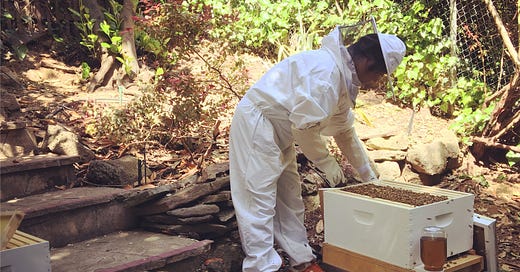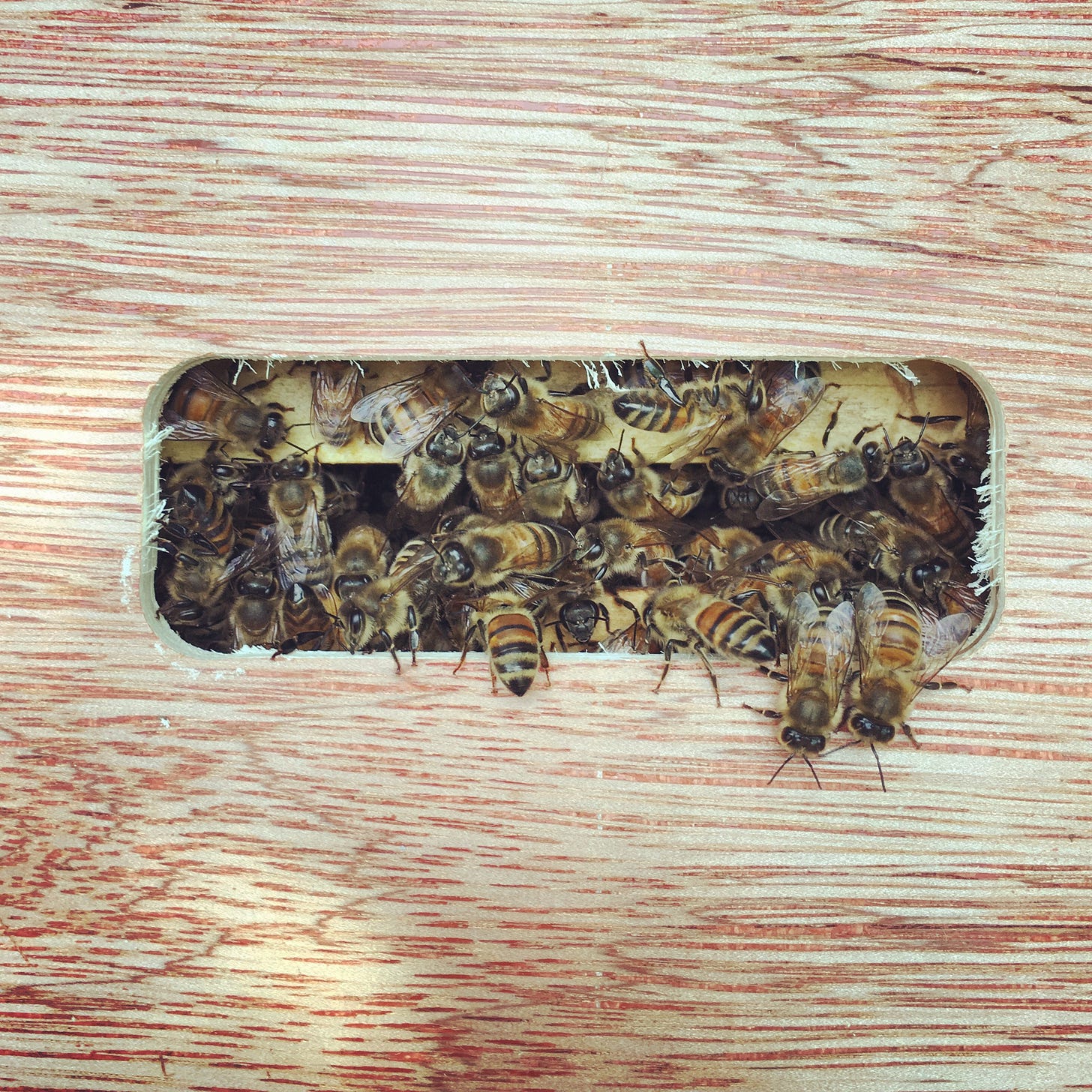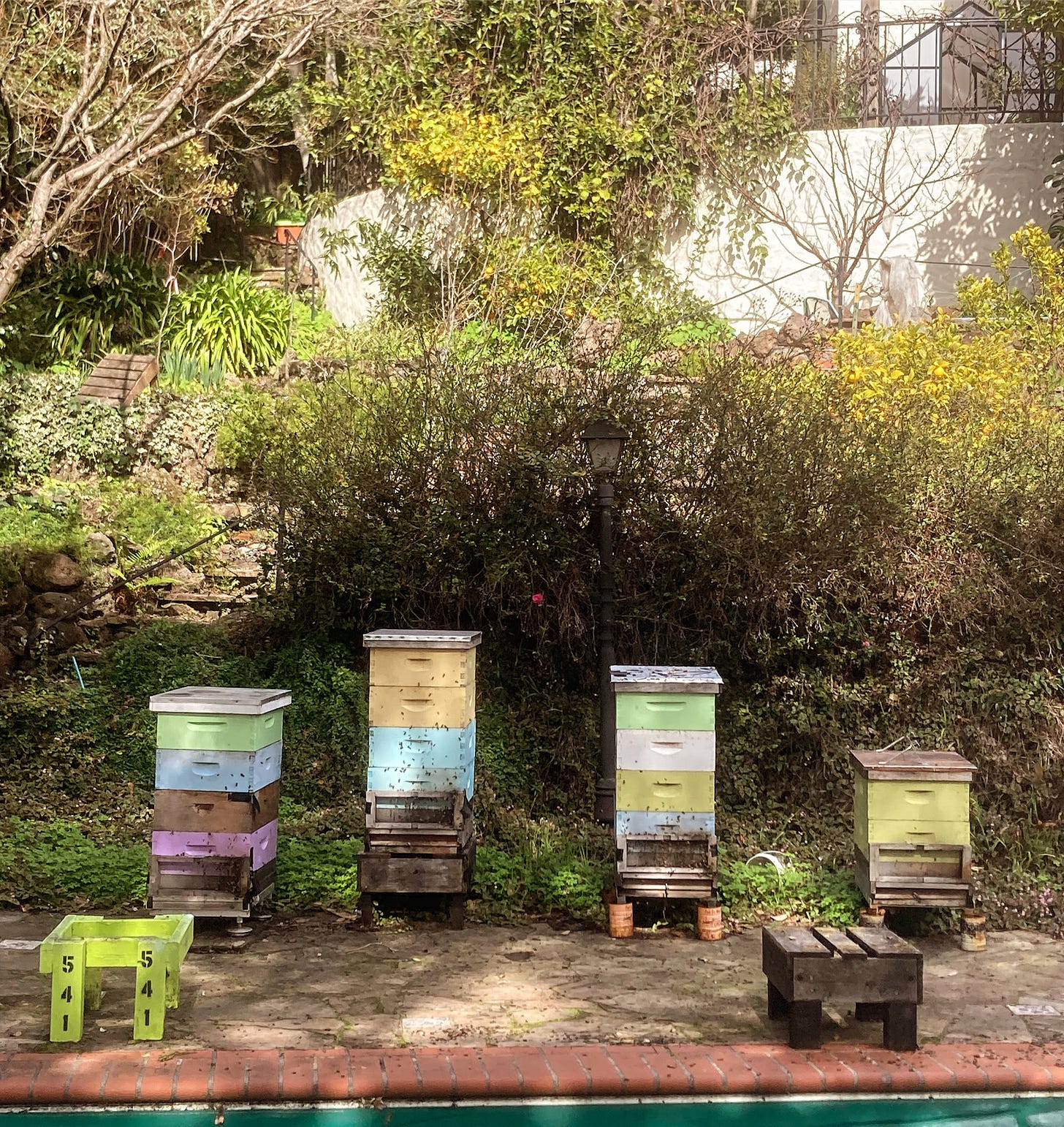This post is going to ramble. It just is. I thought about revising drastically and ripping this apart, as well as all the things I would do if this were a short story or essay. But you know what? It came together in the end. Please bear with me.
Recurring dreams
I have several recurring dreams. Of course, there is the one where I wake up late for a final exam for a class I’ve neglected to attend. Another involves walking into a warehouse of working toilets with varying degrees of approachability, none offering privacy. Often, the cleanest toilets offer the least privacy, while the ones in a corner or nook are the filthiest; meanwhile, I must decide with a full bladder. The lack of choice! Egads. These recurring dreams have a disturbing and anxious vibe.
But my most welcome recurring dream is one in which I live in a home full of indoor beehives. In this honey bee dream, hives of all sizes reside in a sunroom, kitchen, and living room. Some are taller than I am, and others are mating nucs that are only a little bigger than a shoebox. I walk among them without my bee suit. The bees fly about; some take off like a rocket from the landing boards to gather nectar and pollen. Others meander the rooms. We coexist without conflict. The bees are gentle. At nighttime, they huddle in their hives. And in the daytime, they fly out the open windows.
In reality, one would never keep bee hives indoors for many reasons. But in the dream, are indoor hives the norm? Which makes me wonder if I’m even on planet Earth in that dream.
Other times, I dream that someone has shut the windows, leaving bees trapped indoors, starving and irritated. Of course, even dreams are stories; conflicts inevitably arise. Threats dash even my most pleasant dream scenarios.
Despite the tension, this beekeeping dream is not a nightmare. Neither is the toilet warehouse dream. Even the final exam dream isn’t a nightmare. They are at worst, bad dreams.
What is the difference between a dream and a nightmare?
The word dream originally meant a series of images in the unconscious mind. Once, I watched an art installation at the National Museum of Korea: a montage of beautiful images that morphed into one another. It reminded me of dreams.
A dream can carry with it anxiety, fear, and threats. Such a dream is a bad dream.
Worse than a bad dream is a terror-filled nightmare, something from which we often awake from sleep.
The American Dream
Dream is a word of duality that describes both the world of sleep and wakefulness.
A dream in the conscious mind is hope. As a child, my dream was to become a writer. When I spent a childhood falling asleep to the sounds of my parents fighting, I dreamt of being happily married; I made a bargain with G*d and said I’d sacrifice everything for a happy marriage. That dream came true. I sacrificed everything to be happily married.
Then, my marriage ended. I wondered what had happened to my dream.
My marriage was a redwood tree. It was its own beautiful thing. But it also took up all the sunlight. Redwood trees are allelopathic, sending out chemicals that inhibit the growth of other plants. When the redwood disappeared, I became the writer I wanted to become. I was also a new mother, and my daughter’s dreams became a part of my dreams. My dream was to live a life centered around joy. My dream was to try to spread that joy to others. Sure, I can get sad. I definitely get depressed. I’m not a Pollyanna. But I will never underestimate sunlight again. I am out from under a canopy.
My core sadness stems from romancing the American Dream and the heartbreak it can wreak. My parents immigrated to the United States in 1969 for better opportunities for the future they wanted but didn’t feel was possible in post-war South Korea. My parents worked day and night; my mother took nighttime shifts as a nurse so that a parent could always be home with me and my brother. They faced racism in the workplace; my father quit his job as an engineer and owned small businesses for the rest of his life. Their stress was enormous because the stress of the American Dream is enormous.
The American Dream says that if we work hard enough, we will be successful. This is the marketing of America. (For what it’s worth, Auschwitz has a sign that says “Work will set you free” at its entrance).
My mom died, exhausted from toil. She said, “You have to be rich to die with dignity, too. Being middle class is the worst way to die.”
The American Dream has been weaponized in many ways, not the least of which was to pit marginalized groups against each other as a response to the Civil Rights Movement. The government established the Model Minority Myth as an excuse to say it owed minority groups nothing. And it benefited from pitting BIPOC groups against each other.
The duality of the word “dream” (we dream in sleep and we dream while awake) makes it so that hope can feel ineffective, that a dream doesn’t apply to the waking world. A dream can feel so lofty it is unachievable.
What did the founders dream of? Freedom. Amnesty. When did the Constitution feel like a dream?
These days, the real world is not so different from the dream world, nightmares, or terror.
And I wonder when we will wake up because it’s become a nightmare.
The bee dream and the commercial nightmare
The bees continue to visit me in dreams. They follow me through the rooms of my home. I am a witch circled by honey bees. If I were to be a superhero, I would want to be a bee, like Peter Parker is a spider.
In Berkeley, bee season has begun. For the first time in months, temperatures are holding steady at or above 60F. The nighttime temperatures, too, are rising from 40F to near 50F. At 65F or higher, hives can be opened without threat to chilling baby bees.
February is also almond season in California.
While commercial beekeepers earn some money from honey sales, they earn most of their income through pollination, particularly from almond orchards in California. However, this wasn’t always the case. The shift occurred in 2007, when honey prices dipped. Colony collapse disorder caused a 35% hive loss that winter, devastating the industry. At the same time, almond farmers began offering higher prices for pollination services, providing the bee industry with much-needed revenue.
Almonds have become an incredible industry in my state; California grows 80% of the world’s almonds, and almond trees blossom in February, when weather is unpredictable and pollinators scarce. Even though bees in mild climates do raise brood—baby bees—regardless of where a hive resides, the winter bee population remains small until the nectar flow and food supply increase and stimulate growth.
Every year, commercial beekeepers place over 1.6 million bee colonies in California’s almond orchards to facilitate pollination in the midst of what is technically winter. Trucks haul bee hives on pallets across the country in late winter, some from as far away as Florida; out-of-state pollinators outnumber California pollinators two to one. For this service, almond farmers have paid, between 2019 and 2022, an average of $200 per hive for the month almonds bloom (The Bee Corp, 2022).
Thus, almost every commercial bee hive in the country is in the California almond orchards during February and March. It is an unnatural gathering in which bee colonies, already stressed by a long-haul transit, are exposed to pesticides and an increased risk of spreading sickness, like going to a bar during a pandemic without a mask and then also having unprotected sex.
Some colonies move on from the almond orchards to pollinate other monoculture crops at different farms. Still, many return to their original apiary, where commercial beekeepers harvest the almond honey to sell. The commercial beekeepers also “split” the hives to make mini-hives, otherwise known as “nucs,” that they then sell to other beekeepers.
After years of mitigating what people have called “Colony Collapse Disorder,” beekeepers have managed to minimize Varroa mite infestations and disease. Commercial beekeepers have recovered.
But this winter, we’ve heard word from the frontlines. There’s been an uptick in colony die-offs. We’ve not seen a massive number since 2007 (Ellis, San Francisco Chronicle, February 22, 2025).
Beekeeper and researcher Randy Oliver first sounded the alarm in early February when he sent out a letter stating, “After 40 years of successfully fulfilling our almond pollination contracts, for the first time we’re not going to be able to do it this year, due to so many of our colonies dwindling. That despite our controlling varroa, and feeding tens of thousands of dollars’ worth of pollen sub and sugar syrup to stimulate their buildup last fall -- to which they normally respond -- and enjoying a nice alder pollen flow in early January.” (Nevada County Beekeepers Association, February 2025, 3-6).
He adds, “The current situation is again due to a perfect storm of a number of issues coming to a head simultaneously, but all indications is that there is one or more pathogens involved -- I suspect a new virus variant or recombinant. In our own operation, free of pesticides, synthetic miticides, with varroa under control, and nosema not correlating with problems, colonies simply were unable to respond "normally" to fall feeding of pollen sub and syrup. It was frustrating to watch them slowly dwindle, despite feeding truckloads of feed. Hot, dry weather and a diminished natural pollen flow may have been part of it, but since not all colonies in each yard were affected equally, I suspect that a pathogen was involved.”
Since this letter, many other beekeepers have adopted Oliver’s term “dwindling” to describe this phenomenon.
For the record, Randy Oliver is meticulous about caring for his bees. He is on the cutting edge of varroa mite management and generous about sharing his research findings at Scientific Beekeeping. If he can’t keep bee colonies alive, we are all in for quite a ride.
(As an aside, one of my dream writing gigs is to do an in-depth profile on Randy Oliver, as Susan Orlean did on John Laroche).
According to a survey by Project Apis.m, 702 commercial beekeepers reported an average loss of 62% of their hives over the last seven months.
Bee brokers (intermediaries between beekeepers and growers who need pollination) also reported record numbers of dwindling hives, which were notable enough by February to raise the alarm.
Honey bee husbandry researcher Dr. Humberto Boncristiani sat down with bee broker Blake Shook to share insights into the bee die-off. In an Inside the Hive TV episode, Shook noted that some of the largest commercial beekeepers reported a minimum of 50% to 60% losses, spread throughout the whole industry across geographical regions. Hives that looked “phenomenal” in the Fall were dead in January. He said, “No bees in the box with no apparent reason” (Inside the Hive TV, Youtube, February 2025).
Seeing the stacks of dead bee hives in the YouTube video was sad. (And they mention the Project Apis.m survey I stated a few paragraphs earlier).
Shook’s theory is that “something happened last Summer or last Fall that impacted the bees, and we are now just seeing the results.” He said the data is still coming in, but the situation looks worse than CCD (Colony Collapse Disorder).
In Alameda County, hobbyist beekeepers haven’t experienced massive die-offs. In an informal survey, beekeepers didn’t note losses greater than any other year. Data is still coming in.
We don’t know if the same is happening to European beekeepers. But a Ukrainian friend once told me, “Good news travels fast. But bad news travels faster,” meaning, we would have heard bad news by now.
A plague among us
There’s some link between my dreams and reality. Some delicate balance between joy and dread and terror. Some link between the bees and the state of our world. A plague striking honey bees in America. But maybe in Europe, too.
Researchers cannot help but compare this massive die-off to Colony Collapse Disorder (CCD), the last time such a catastrophe occurred. However, the comparisons don’t go very far because we never figured out the root cause of CCD. The similarity begins and ends with “They just died.”
Researchers, too, wonder if this die-off is something cyclical in nature. Something that strikes bee colonies, which survive, and to which colonies succumb again a decade later. A rise and a fall. A swing from left to right.
Here we are again.





